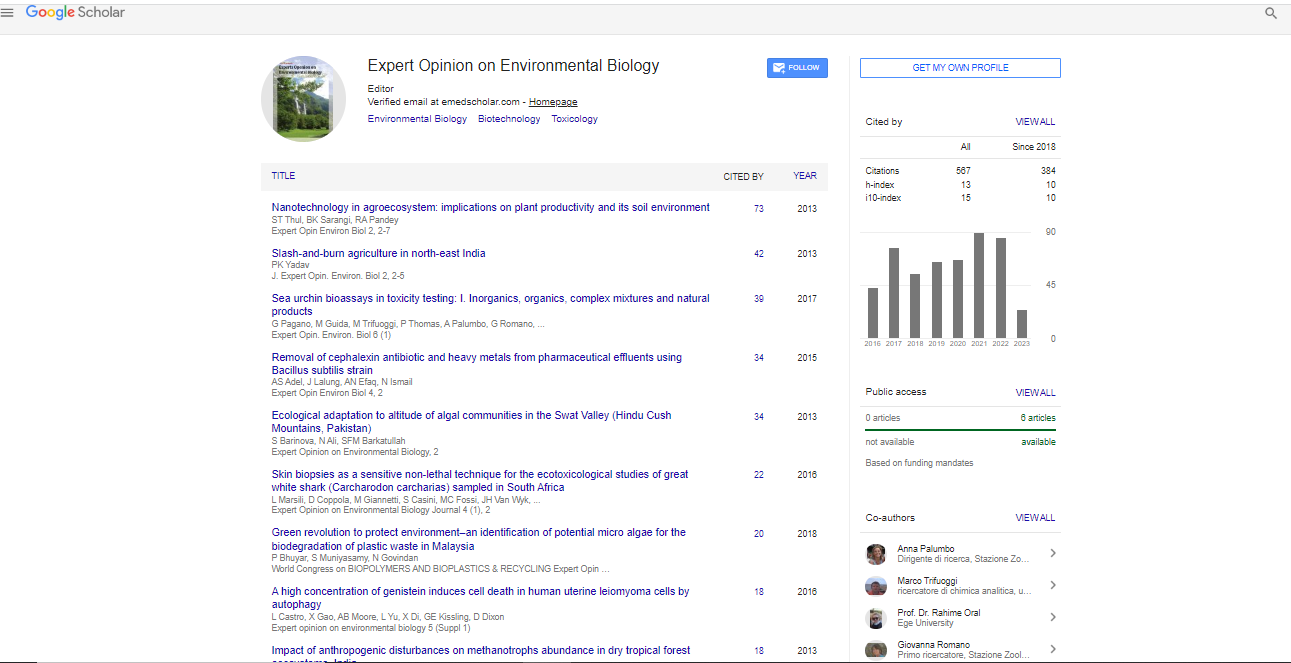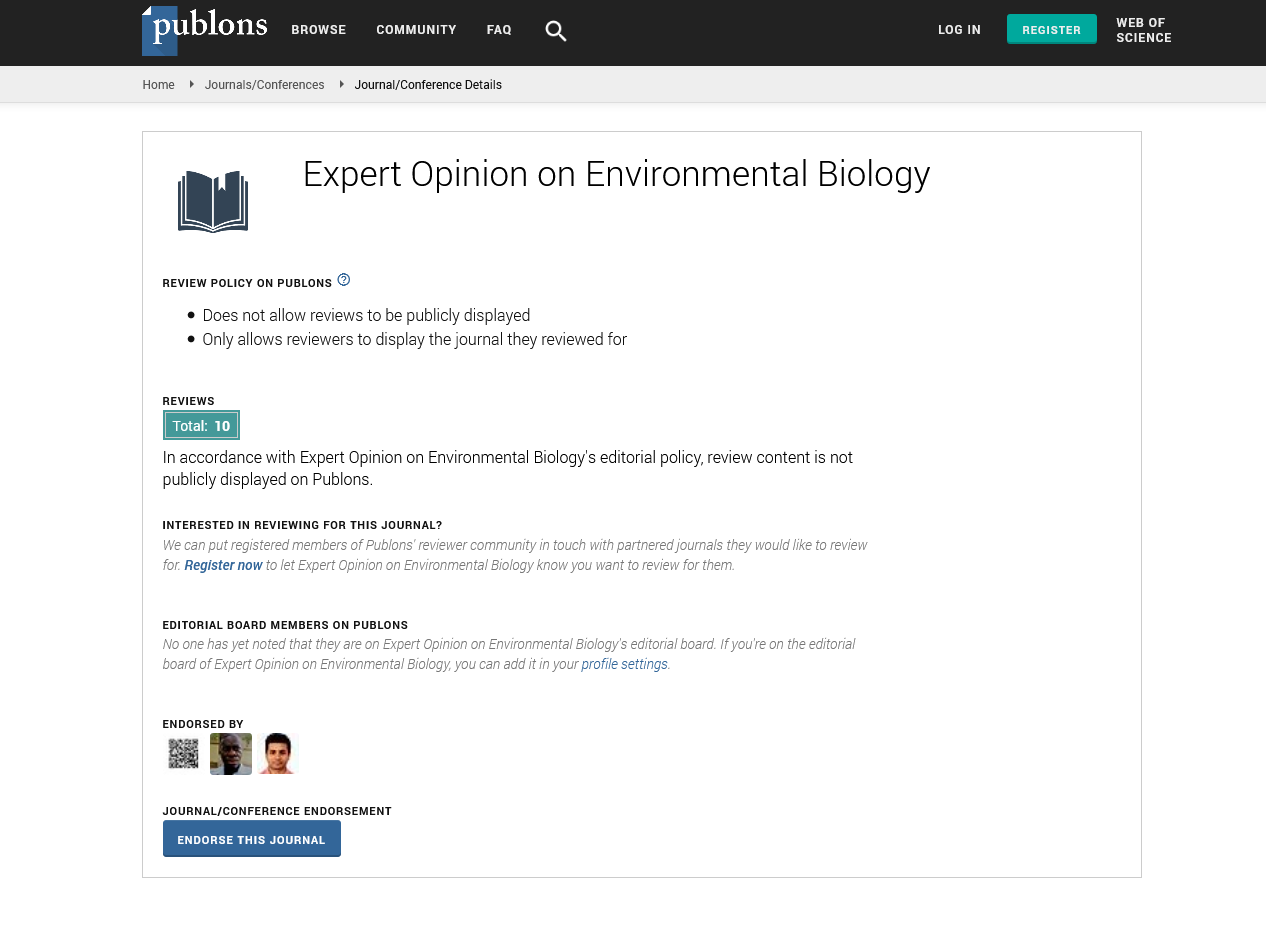Short Communication, Expert Opin Environ Biol Vol: 14 Issue: 1
Climate Change and Biodiversity Loss: Understanding the Interconnection
Sarah Harris*
Department of Environmental Engineering, Stanford University, United States of America
- *Corresponding Author:
- Sarah Harris
Department of Environmental Engineering, Stanford University, United States of America
E-mail: sarah_harrissu@22.edu
Received: 01-Mar-2025, Manuscript No. EOEB-25-169975, Editor assigned: 03-Mar-2025, PreQC No. EOEB-25-169975(PQ), Reviewed: 17-Mar-2025, QC No. EOEB-25-169975, Revised: 21-Mar-2025, Manuscript No. EOEB-25-169975(R), Published: 28-Mar-2025, DOI: 10.4172/ 2325-9655.1000237
Citation: Erik K (2025) Advancing Cardiac Healing: The Role of Stem Cells in Regeneration and Future Prospects. J Regen Med 14:1.
Copyright: © 2025 Erik K. This is an open-access article distributed under the terms of the Creative Commons Attribution License, which permits unrestricted use, distribution and reproduction in any medium, provided the original author and source are credited.
Abstract
Climate change has emerged as a significant driver of biodiversity
loss worldwide. Rising temperatures, altered precipitation patterns,
and increased frequency of extreme weather events are disrupting
ecosystems, threatening species survival, and altering ecological
interactions. This article explores the complex relationship between
climate change and biodiversity loss, highlighting mechanisms,
consequences, and possible mitigation strategies. Understanding
this interplay is crucial for developing policies and conservation
practices to preserve global biodiversity.
Keywords: Climate change; Biodiversity loss; Ecosystems; Habitat degradation; Conservation strategies
Keywords
Climate change; Biodiversity loss; Ecosystems; Habitat degradation; Conservation strategies
Introduction
Biodiversity is essential for ecosystem stability, human livelihoods, and global ecological health. However, anthropogenic climate change has intensified pressures on already vulnerable species and habitats. The Intergovernmental Panel on Climate Change (IPCC) warns that without significant mitigation efforts, many species face heightened extinction risks due to shifting climatic conditions, habitat fragmentation, and loss of ecological niches. This article examines the pathways through which climate change drives biodiversity loss and identifies measures to address the crisis [1].
Description
Climate change affects biodiversity through several direct and indirect pathways:
- Habitat shifts â?? Many species are forced to migrate toward cooler regions or higher altitudes, but fragmented landscapes often limit such movement.
- Phenological changes â?? Altered seasonal cycles affect breeding, migration, and flowering times, disrupting species interactions.
- Increased extinction risks â?? Specialized species with narrow ecological niches are particularly vulnerable to climate fluctuations.
- Coral reef decline â?? Ocean warming and acidification have caused mass coral bleaching, threatening marine biodiversity.
- Invasive species expansion â?? Warmer climates facilitate the spread of invasive species, which compete with and displace native flora and fauna [2], [3].
The combination of these factors accelerates biodiversity loss, undermining ecosystem resilience and reducing natureâ??s capacity to provide essential services, such as pollination, water purification, and carbon storage.
Results
Research has shown alarming trends: tropical regions are experiencing rapid declines in amphibian and bird populations due to habitat loss and temperature extremes; Arctic species such as polar bears face habitat loss from melting sea ice; and marine biodiversity hotspots are shrinking due to warming waters and acidification. Climate-driven biodiversity loss also has socio-economic consequences, as communities dependent on ecosystem services face reduced food security, water availability, and climate regulation benefits [4], [5].
Conclusion
Climate change and biodiversity loss are interconnected crises that require integrated solutions. Conservation efforts must incorporate climate adaptation strategies, habitat connectivity, and species migration corridors. Additionally, reducing greenhouse gas emissions, promoting ecosystem restoration, and strengthening international conservation policies are critical for preserving biodiversity in a warming world.
References
- Alhaji TA, Jim-Saiki LO, Giwa JE, Adedeji AK, Obasi EO (2015) Infrastructure constraints in artisanal fish production in the coastal area of Ondo State, Nigeria. IJRHSS 2: 22-29.
- Gábor GS (2005) Co-operative identity-A Theoretical concept for dynamic analysis of practical cooperation: The Dutch case. Paper prepared for presentation at the XIth International Congress of the EAAE (European Association of Agricultural Economists), â??The Future of Rural Europe in the Global Agri-Food Systemâ??, Copenhagen, Denmark.
- Gbigbi TM, Achoja FO (2019) Cooperative Financing and the Growth of Catfish Aquaculture Value Chain in Nigeria. Croatian Journal of Fisheries 77: 263-270.
- Oladeji JO, Oyesola J (2000) Comparative analysis of livestock production of cooperative and non-cooperative farmers association in Ilorin West Local Government of Kwara State. Proceeding of 5th Annual Conference of ASAN 19-22.
- Otto G, Ukpere WI (2012) National Security and Development in Nigeria. AJBM 6:6765-6770
 Spanish
Spanish  Chinese
Chinese  Russian
Russian  German
German  French
French  Japanese
Japanese  Portuguese
Portuguese  Hindi
Hindi 
